Thanks for your support! If you make a purchase using our links in this article, we may make a commission. And, as an Amazon Associate, I earn from qualifying purchases. See the full disclosure here.
Updated April 12, 2024
Wouldn’t it be nice if you could dump your RV’s holding tanks at home? We dump our RV tanks at home and it is much more convenient than sitting in line at the campground dump station on a Sunday morning. Well, guess what. You are in luck! You may be able to dump your RV tanks at home too!
Dumping your RV’s black and gray water-holding tanks at home isn’t that difficult. Several standard methods are employed to handle this task, and this article will cover four of them.
Let’s just say it: Dumping tanks is much like exes—no one likes talking about them! But it is one of those topics in full-time RV living or even if you are a weekend warrior type camper that needs to be discussed openly.
Knowing how to take care of your RV tanks is one of the items that should be at the top of your maintenance checklist, and dumping your tanks at home is easy and convenient.
Check out the video at the end of the article, where we show you how we dump our black and gray tanks at home.
Why Dump RV Tanks At Home?
My short answer is that dumping your RV tanks at home is convenient and free. But let’s not recreate the scene from Chevy Chase’s National Lampoon’s Christmas Vacation movie where the Griswald’s cousin Eddie dumped his RV waste into the city’s streetside sewer. Never do that for the same reason you see in the movie!
The best part, besides the budget-friendly advantage, is how easy it is to do at home. But one major no-no is dumping the grey or black tanks onto the ground. Obviously, this will pollute the environment and most likely result in some local fines. Remember to always use safe disposal systems for dumping your wastewater.
Is it Legal to Dump My RV Tanks at Home?
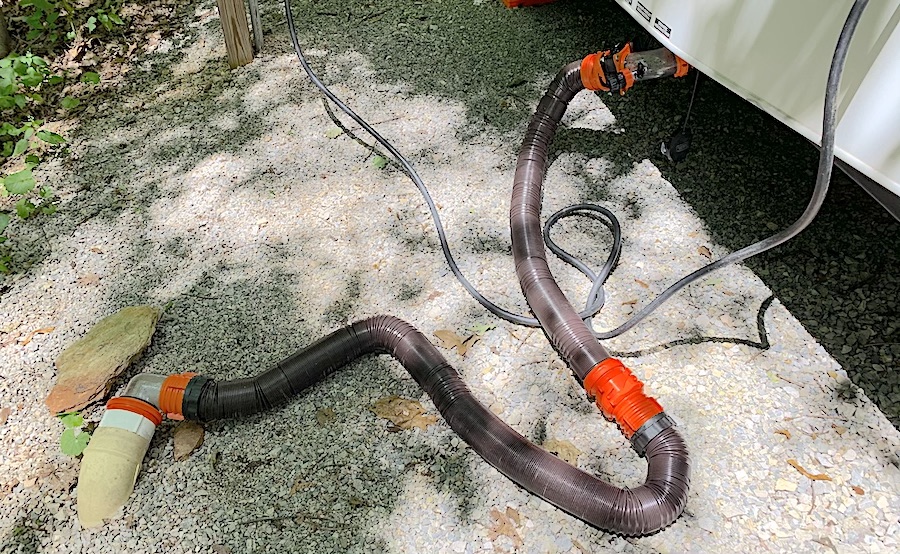
In most cases, it is legal to dump your RV’s black and gray water tanks into an approved residential sewer system. However, there may be local ordinances and restrictions, and you should check them. The black and gray water from your RV is essentially the same as what comes from your toilets and sinks at home.
If you are dumping into an actual municipal sewer line, often called a “sanitary line,” you should have no problems. However, you do need to be sure you are not dumping into a storm drain. These often go to reservoirs, and this could get you into real trouble, including a hefty fine.
One note before we get started: Never empty your gray or black water tanks onto the ground. Doing so will contaminate the environment and can result in some pretty hefty fines. Always use a safe disposal system, like a sewer or septic system, for dumping your RV waste.
What Should You Do If You Have A Black Water Spill?
Aside from ruining your day (depending on the extent of the spill), it’s doubtful you’ll need to contact the EPA or OSHA. You should clean up the area to the best of your ability. Again, depending on the degree of spilled black water, what you use and how you go about it will change.
Black water contains harmful microbes and whatever chemicals may have been used in the cleaning process. Wet vacuum everything you can, and use disinfectants and bleach to clean solid surfaces.
After it’s been decontaminated, use fans to dry everything out. If you spill it outside, notify the party responsible for the land. Depending on the severity, they may call in a professional.
Lime works well for decontaminating the surrounding ground the best you can. Avoid using household chemicals outdoors since it will cause more environmental damage than the original spill.
Can I Dump My RV Tanks Into My Private Septic System?
If your home has a septic system, you can also dump your RV waste-holding tanks into your septic tank! Your gray and black tanks are safe to empty into your septic system. Just know there are some critical issues you will want to keep in mind to ensure that both you and your septic system’s bacterial environment stay healthy.
The great thing about using your sewer system at home is that you can also dump your gray water. If you use biodegradable, septic system-friendly products that quickly break down, you can drop both tanks with no issue.
When using dish soap, shampoo, cleaning products, and toilet paper in a conventional sewer system, the composition of those products isn’t a concern. However, with a septic system, it’s essential to be conscious of the kinds of products you’re using.
Not all products interact well with a septic system. By using products that do not interfere with the septic system’s naturally occurring waste break-down process, you can ensure your septic system lasts for a very long time.
Most folks don’t realize that using antibacterial soaps at home is not recommended if they have a septic system. A septic system uses bacteria to help break down the waste, and antibacterial hand soaps can kill helpful bacteria.
Can A Septic Truck Pump Out RV Tanks?
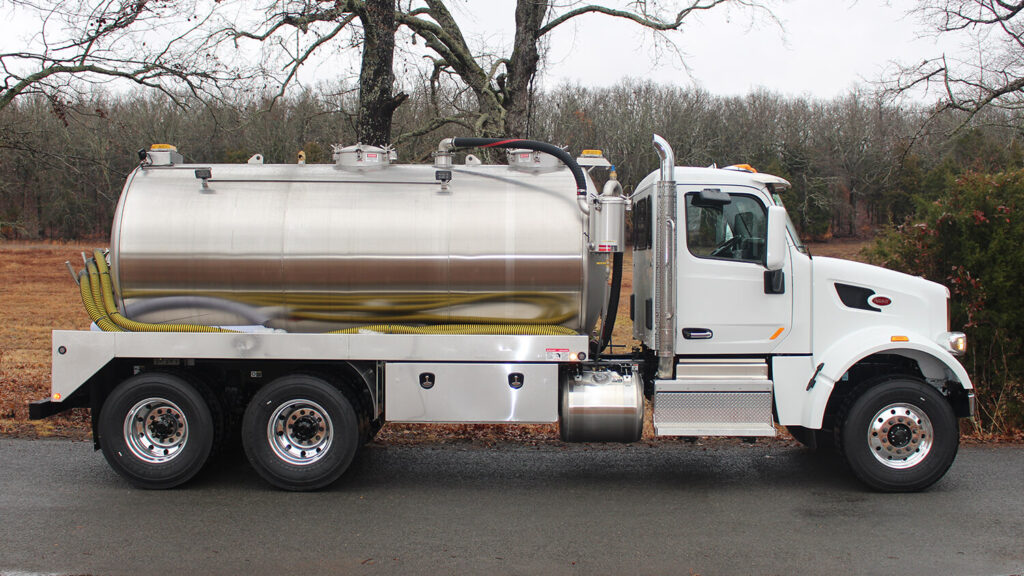
A septic truck is perfectly capable of pumping out RV tanks. In fact, there are professional services for just that. You don’t have to pay under the table for it. Though a professional job is just that, you still have to participate in the endeavor.
For example, once the black tank is pumped out, you will need to fill it with water and have it pumped again. This will help ensure that the tank is completely clean. You may have to do it a few times to be sure.
It’s highly advisable to open your toilet valve before the process begins. The suction power from a pump truck is often enough to implode your black tank.
It can also flatten your toilet or destroy a plastic one. If you prefer to avoid your black tank and toilet going the way of a crushed aluminum can, open up that valve before the pump truck kicks things off.
Types of RV Tanks
I’d like to share with you the different types of RV water tanks before we jump into how we can dump our RV tanks at home. Many of you are new RVers and may like to know the difference between black water, grey water, and freshwater tanks.
- Black Water Tank – this is the nasty sewage and wastewater from your RV toilet.
- Grey Water Tank – this holds your RV’s dirty water from your shower and sinks when you wash dishes, or brush your teeth for example.
- Fresh Water Tank – this is obviously your cleanest tank that supplies your faucets and shower with fresh water.
For an in-depth explanation about the types of RV tanks check out our article called What Are RV Holding Tanks and How Do They Work?
What Is Black Water?
As stated earlier, RV black water is that which your toilet sewer system (aka human waste) dumps into. Always dump your RV black water tanks first! Why? Because then you can use the gray water tank to semi-clean and wash out your hose.
What Is Grey Water?
Grey wastewater comes from your kitchen sink, shower, and bathroom sink drain.
Almost all of the RVs have all three water tanks – grey, black, and freshwater. However, you may have a vintage trailer camper that does not have a grey water tank. If this is your situation, you can purchase and install a grey water tank.
Do I Really Need to Use RV Safe Toilet Paper?
Do Black Tank Treatments Work?
Black tank treatments work just fine and come in several forms—pods, powders, and liquids. The treatments help by breaking down solids in the tank, making it easier to clean. They also help maintain your tank sensors and tamp down the odor.
Of course, the best black tank treatment is the one you use. Establish a routine with it. Some RVers use them more than others, but not using them at all will only make the pumping or cleaning process more difficult.
We had our black and gray tanks professionally cleaned by Kleen Tank after two years on the road, and we received grades on the cleanliness of our tanks A and A-. According to Kleen Tank, the best thing you can do to keep your tanks clean is to use a lot of water when flushing.
We have done this over the past two years, and it has worked!
How to Dump Your RV Tanks at Home
Here are the four most common methods you can use to empty your RV’s wastewater tanks. Two of them may require the purchase of specialized tools. For another, you will only need a bucket. Well, perhaps a clothespin or a dab of Vicks Vapor Rub for your nose.
Here are the four most common methods for dumping your RV’s holding tanks at home:
1. Dump Your RV Tanks into the Cleanout Pipe
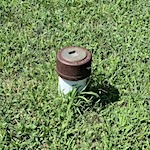
Most folks have a sewage disposal system that is private or public. A private sewage system is typically called a septic system and a public sewage disposal system is called a residential sanitary sewer or residential sewer system. Both types almost always have what is called a cleanout. You can see a cleanout in the picture to the right.
It might look like a sewer cleanout you have seen when at a campground and the idea is exactly the same. just run your sewer hose from your RV to the cleanout and dump your black and then your gray water tanks.
If you have a septic system, you are allowed to dump without making sure it is allowed in your jurisdiction. But if you have a public sewer system, you need to check before dumping. I also suggest being a good neighbor and letting your neighbor know you have checked and that you will be dumping your sewer tank once in a while.
We typically don’t dump at home, but every now and then, we go away for a weekend and there are no hookups, so we end up dumping at home. Or, when we clean the RV tank system, we will dump it at home, too.
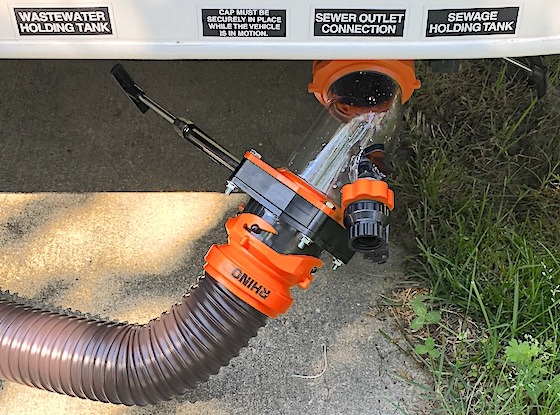
I also highly recommend getting a RhinoFLEX Rhino Blaster with a gate valve to make cleaning your black water tank easier. We used to dump our black water tank and then if we wanted to rinse it thoroughly we would need to refill it by running a hose with a septic cleaning wand through the RV window and down the toilet, or we would have to hold the toilet handle and run water for 15 minutes until the tank was full.
Then we bought a RhinoFLEX Rhino Blaster. See the picture to the right. The great thing about the Rhino Blaster is that we can attach a garden hose right to it and quickly fill the black tank.
The key is to buy the Rhino Blaster with the gate valve. With the gate valve closed, it holds water in, so you can open the black tank valve and fill the black tank to flush it out with clean water. It is a time saver and it’s very convenient.
Over the past four years, quite a few people have asked us how we know when the tanks are full. We have a tank level indicator inside our RV, and Susan stands inside and watches it. When the tank is full, I turn off the water and drain it.
If you don’t have a tank level indicator, then someone needs to stand inside with a flashlight and look down the toilet to see when the water level rises.
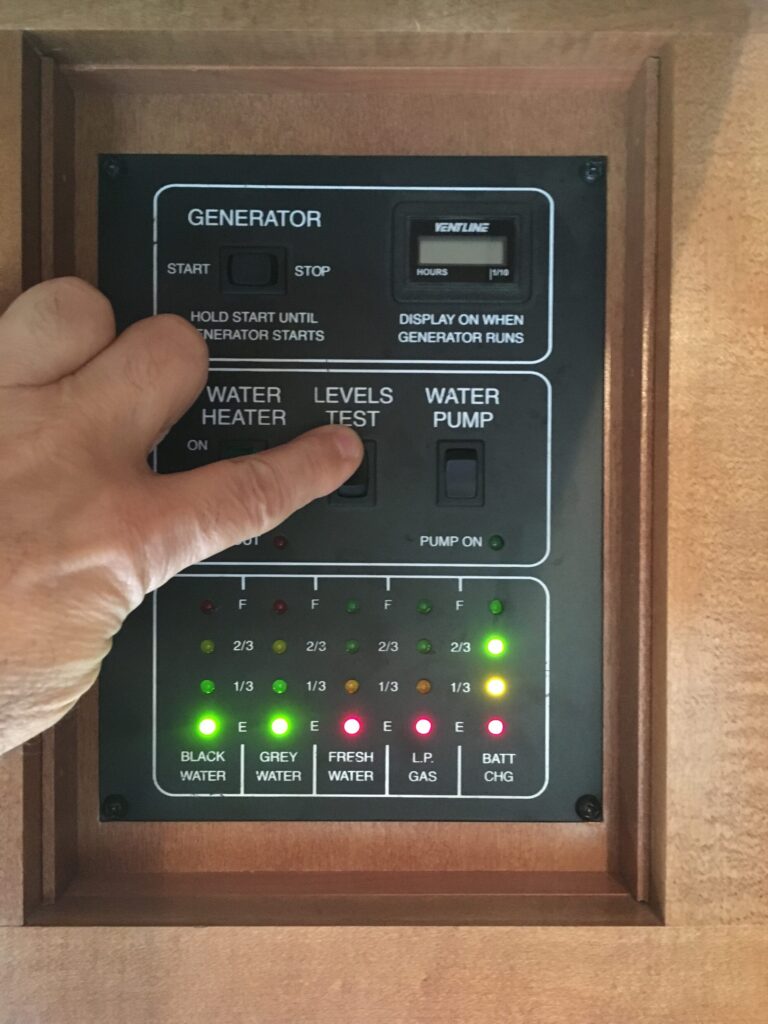
2. The Bucket Method
The bucket method is the simplest but should only be used if you have no other way to dump your tanks.
If this is the case, the bucket method is an option, but you will be exposed to raw sewage, so take extreme care.
It is quite simple:
- Get a bucket
- Carefully release your RV’s tank into the bucket until it is full
- Pour the contents of the bucket into your toilet and flush
- Repeat until the tank is empty
- Clean the bucket out
As you can see, this is a straightforward solution to emptying your tanks at home. While it may not be enjoyable when it comes to the black tank, it’s not bad if you only have a little gray water to get rid of. And, as with all dumping techniques, wearing gloves during the process is recommended.
The best gloves I have found are Heavy Duty Orange Nitrile 8 Mil Disposable Gloves with Diamond Texture. Most disposable gloves are only 4 to 6 mil and sometimes they rip or tear. Mil refers to the thickness of the rubber. But the 8 mil rubber gloves hold up much better and the diamond grip is fantastic.
3. The Macerator Method
The macerator method is the most challenging option, but it is also a good option for those who do not have a septic system and still want to be able to dump out the whole tank at home.
This method involves grinding everything in your tank with a macerator and converting it into a sludge. You will then funnel the sludge into your toilet using a garden hose.
This method does require the purchase of some special equipment. Typically, everything you need will cost about $200 to $250.
Required Items:
- RV waste macerator Pump
- Hose adapter
- CDFJ adapter
- Garden Hose (It is recommended that you use a separate hose for this and not the garden hose you use for your lawn and garden)
Step-By-Step Instructions
1. First, connect the macerator to your waste outlet (You can attach the hose adapter to your RV’s waste outlet to get a better angle and to allow for better monitoring of the contents of the tank).
2. Plug your pump in (These can often be connected to your RV batteries).
3. Using the CDFJ adapter, connect the garden hose to the macerator.
4. Run the garden hose into your toilet at home. A larger-diameter hose and a more powerful pump are recommended for long distances.
5. Open your RV’s waste release valve and turn the macerator on.
6. Be prepared to flush the toilet as often as required.
7. Run clean water through the system to make sure everything is cleaned out. It is at this stage the transparent adapter helps.
8. Once clear water runs from your RV, you are done. This method takes a while, so you will need to be patient.
9. When finished, turn off the pump and disconnect everything.
4. The Septic Tank Method
Emptying your holding tanks into a septic system is perhaps the best method and, if you have a cleanout, the easiest way as well. The cleanout is a PVC pipe that is above ground with a screw cap. The cleanout is found between the house and the septic tank.
Using the Cleanout
The best way to access the septic system is by using your septic system’s cleanout. Remove the screw-on cap and securely attach your RV hose to the cleanout. Make sure it is well secured. You do not want the connection breaking loose while you empty your wastewater tanks!
Once you have hooked everything up, you may leave it as you would at any RV park. You can also remove it once you are done.
Using the Septic Tank’s Access Port
If using the cleanout isn’t an option, you can also use your septic tank’s access port. However, this method is not nearly as attractive.
Carefully remove the lid. Lifting the cover may take two people. Make sure to avoid any of the fumes that are released. They can be deadly.
When using the access port, be sure that you are dumping on the side of the baffle that accepts solids. This will be the side of the access port closest to the house.
Note that you should not leave your RV hooked up when using the Access Port because of the fumes as well as the possibility of killing the helpful bacteria in your septic tank.
You need to be especially careful when using the access port. It is vital to avoid the deadly fumes that emanate from your septic tank, and always use the side of the tank that collects solids (the side nearest to the house). Be careful not to use any chemicals in your RV black tank that can kill the beneficial bacteria that break down the waste in your septic tank.
How Often Should I Empty My Black Water Tank?
If you think you only have to dump your RV black water tank once at the end of your trip think again! You should dump your RV black tank when it is at least 2/3 full or more. You can use your tank sensors to keep an eye on the levels and then go ahead and dump your tanks.
Can I Leave My Black Tank Valve Open?
We get this question all the time, and the answer is no. You should not leave your black tank valve open when you are hooked up while camping or at home. Some of the waste in the black tank is solid, and it needs the pressure of an almost full tank to help force the waste out of the tank and into the sewer connection.
Can I Flush My Black Tank at Home?
Great question, and yes, you can. After you dump your RV black tank, it is the perfect time to fill it with clean water and flush it out to ensure you clear the tank. This will keep debris from building up inside your tank over time.
Honestly, you’ll want to do regular upkeep and maintenance on your RV waste tank, so you don’t run into problems later that are costly and a pain to deal with if you are out in the wilderness somewhere!
Since you will already be hooked up to a sewer system it’s very easy and just takes an extra 10 to 15 minutes tops. Just remember, plumbing in your RV is different from plumbing at your house connected to the city sewer system.
Your RV holding tanks are probably one if not the most important parts of your camper because it is what makes it possible to use your bathroom and kitchen efficiently and safely.
What to Do if You Don’t Have Tank Level Indicators?

Fortunately, typical RV holding tank sizes are pretty good. Of course, if you have a 15-foot canned ham camper, your tanks will be smaller than those of a large Class A RV. No matter what size holding tanks you have, your owner’s manual or RV dealer will have that information for you.
Every RV couple or family uses their holding tanks differently. Since it is based on personal use, the time you can go between dumping your black and gray water tanks will vary from person to person. Fortunately, most newer RVs have an onboard tank level sensor indicator.
However, very small and older trailers probably will not have a tank sensor system included. If this is your case, then if things rise up (yes, you know, such as wastewater not flushing or coming up in your tub or toilet!), then your RV tanks are full, and you need to dump them.
But here is a very important rule to follow: as tempting as it may be to dump before they are completely full, you should always wait, especially in the cold winter months when smaller amounts of wastewater are likely to freeze.
Benefits & Risks of Emptying Your RV Tanks At Home
The benefits of emptying your RV tanks at home are convenience and budget (some dump stations do charge a small fee).
The risks of doing so are if you improperly dispose of your RV waste and end up paying a city fine or ruining your property. However, this should not be the case if you follow our suggestions here.
How to Stay Safe While Dumping RV Tanks at Home
Perhaps the thought of disposing of your RV’s black water, grey water, and freshwater tanks scares you to death. If so, don’t give up on this RV lifestyle just yet. There is still hope!
The best way to stay safe is to avoid coming into contact with wastewater. So, be sure your connections are tight, use septic hose weights to prevent the sewer hose from popping out of the connection, wear gloves, and wash or sanitize your hands when you are done.
Don’t know what sewer weights are? Check out our article called What are RV Sewer Hose Weights?
What About Dumping Gray Water at Home?
Yes, you can dump your grey water tank at home, too! Here are some tips for dumping grey water at home.
- Always dump the grey tank after the black tank. This helps completely rinse and flush the black water and any leftover solids through the hose.
- It’s a good idea to fill and flush your grey tank too!
As an additional note, you can leave your grey water tank valve open while you are hooked up to a sewer connection. Since grey water contains no solid waste the water will drain freely with no obstructions. Just close the grey valve near the end of your trip to fill it so you can use the grey water to flush the black water through the sewer hose.
What if I Can’t Dump My RV Tanks at Home?
If you are staying at a campground, state park, or national park, there usually is a dump station on the premises. So you might have to wait in line to dump your tanks. I have stayed at a few that did not have a dump station, but this is fairly rare.
Another option is to get the RV Dump Station Finder app, which allows you to find dump stations near you wherever you are and dump your tanks before you get home.
Final Words About Dumping RV Tanks At Home
As you can see, dumping your RV’s waste tanks at home is not a problem, and there are several methods to do so. It is also clear that if your home has a septic system with a cleanout access point, you are way ahead in the game.
Remember that there are some considerations as well as some real hazards that need to be taken into serious account to ensure the dumping process goes smoothly and safely. Dumping your RV’s tanks at home is certainly doable and a great option for many RV owners out there.
Do you have any additional tips or advice for dumping RV tanks at home? Please leave your comments below.
Related Reading:
– How to Clean and Store an RV Sewer Hose
– How Do I Support My RV Sewer Hose?
– What are RV Sewer Hose Weights?
– How to Clean Your RV Black Tank in 3 Simple Steps
Mike Scarpignato – Bio
Mike Scarpignato created RVBlogger.com over five years ago in 2018 to share all we have learned about RV camping.
Mike is an avid outdoorsman with decades of experience tent camping and traveling in his 2008 Gulf Stream Conquest Class C RV and 2021 Thor Challenger Class A motorhome.
We attend RV Shows and visit RV dealerships all across the country to tour and review drivable motorhomes and towable trailers to provide the best evaluations of these RVs in our blog articles and YouTube videos.
We are 3/4-time RVers who created RVBlogger.com to provide helpful information about all kinds of RVs and related products, gear, camping memberships, tips, hacks and advice.


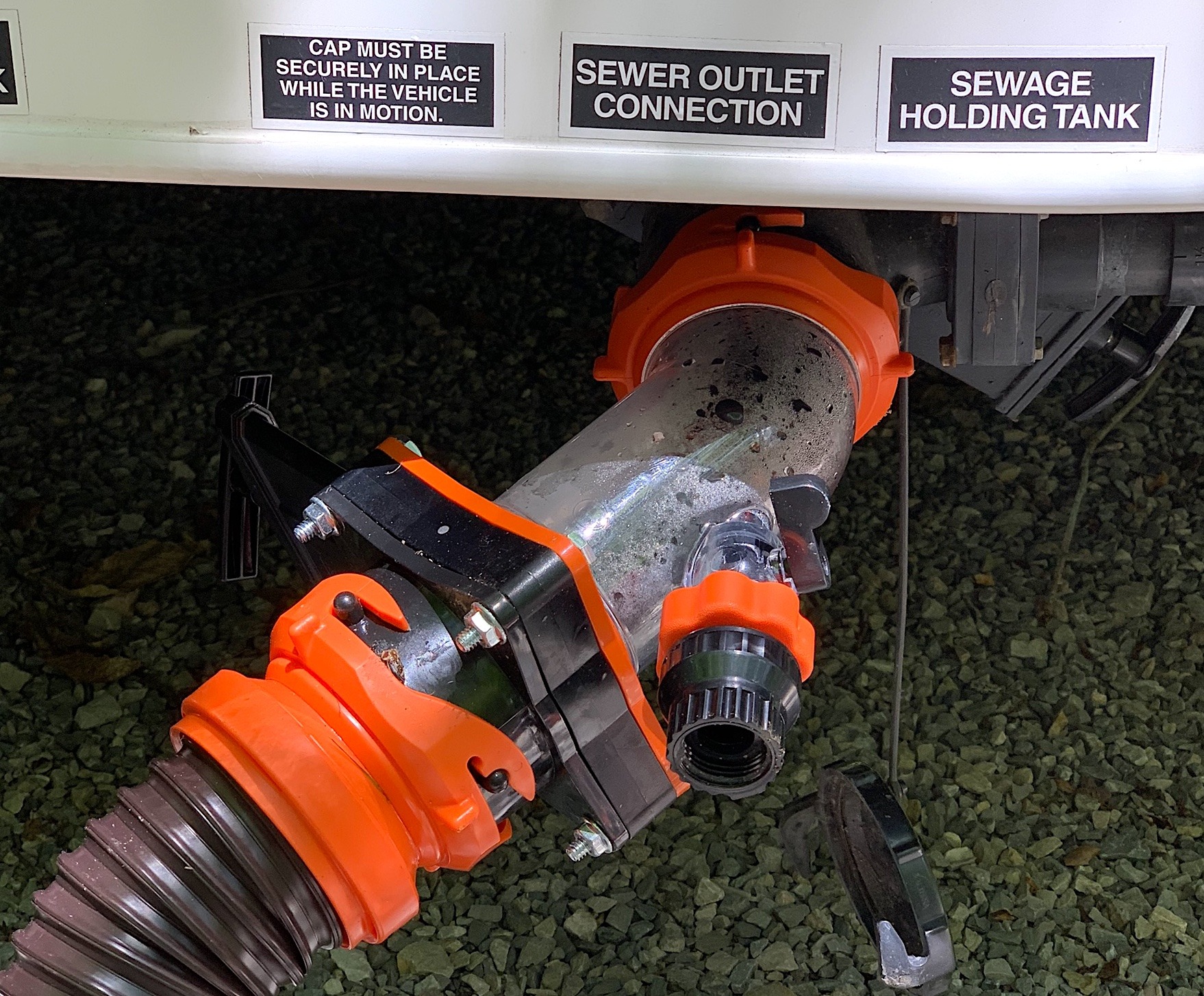
Good point Mike
I have been dumping my RV Tanks into my sept system for over 50 years,
But I also take care of my system within my RV.
1. No Mather which way I am coming home from a Snow Bird trip or one to see other states I check all roads ways coming home as to where there is a rest area and does it have a dump station.
You ask, If I dump at home why do I care? I look at it this way,
1. I can dump at a rest area after pulling some 100 miles or more in which the Black/Gray tanks have ben mixed up. (than I dump tanks) I add cleaning material in each tank and than fill each tank to around 1/3 full. Complete the trip to the house OR you can take it to the next Highway dump station and dump each tank. I know you are on your way home but take a little time for this and you will have lest problems and your tanks leaver readings will be reading true. You will also get all the heavy stuff out of your tanks. Just in case you have hose break lose at your home, you will be 80 clean and it is a good chance that your friends will not note a problem. Also, you might come in at night, so there will not be that rush to dump thanks.
It is a terrible idea to dump 150+ gallons of RV waste into your septic system, doing so creates turbulence in your septic tank and causes solids to be pushed out to the drain field causing premature failure.
You are RIGHT, but you should not dump Stright into your tank. inside your tank is another world and also stop’s those good little things that break down the material be for it goes to the drain field.
I run it some 50/60 feet and into a trap to slow down the speed. That lets those things have their chance before they send it off to their friends in the drain field.
Can u use the grey water to water plants?
I would NOT” Because it is called GREY water does not mean it is free of bad things.
Gray water is things like all kinds of SOAP and cleaners to remove grease. and other types of cleaning products. What about the stuff women use to Dall themself up =Men too. this never gets into the Black water tank. In my rig the only other water that goes into the Black water is from the water sink in the bathroom.
Are you able to just drain it on the ground without using a septic hose?
First – wither it is Black or Gray water in most cases it would no be good to do this.
The other thing is they make equipment to pump out your tanks without using a septic hose..
They make a grander/pump just for pumping some 200/250 feet to a your system. the hose is 3/4″, this slows down the speed and make sure there is no lumps going into your sept system. so in respects it helping you sept system take care of the waste faster. And for the things that breakdown in help them by should we say its not a bake patio it comes to them mash.
How can I find out if dumping is legal where I live? I can’t find info on it anywhere. I’m in Southern California.
Hi Marisa,
Your county government website would be a good place to look. It might be under Department of Sanitation or Water and Sewer. You can also call your county government and ask to speak with someone in that department or ask if they can tell you where their guidelines are located on their website.
Hope that helps!
Mike